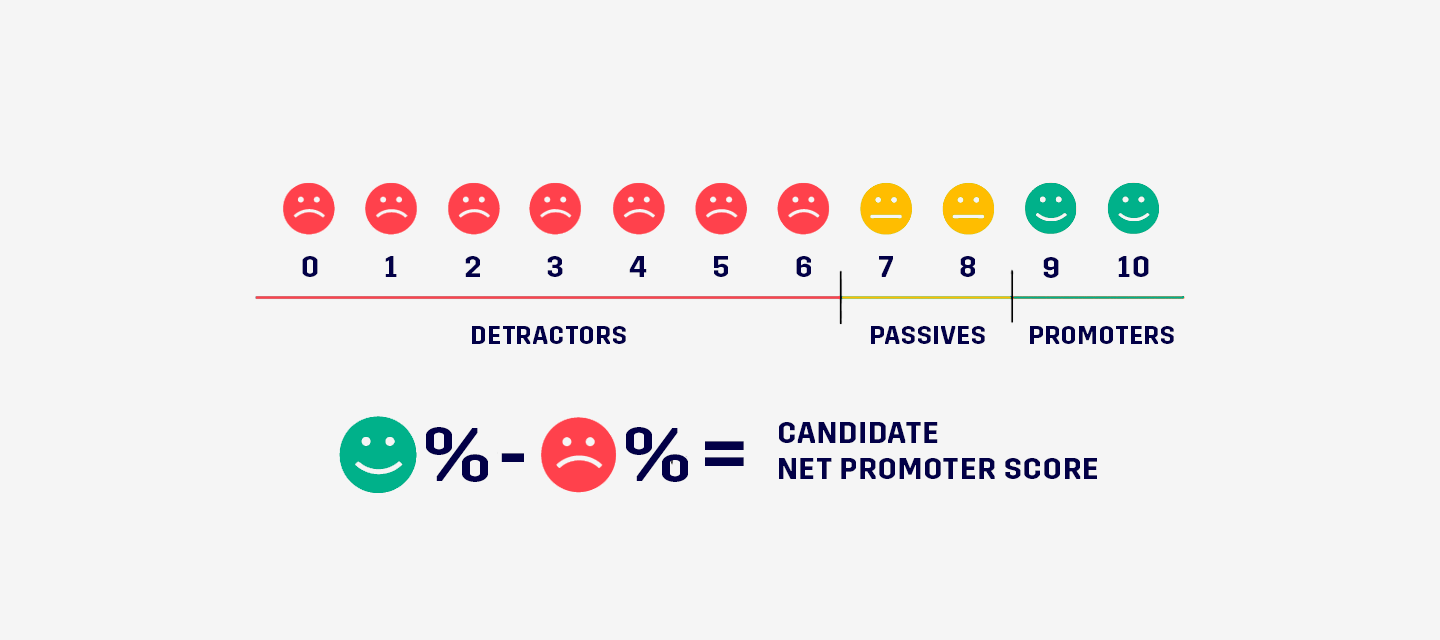You may think that there’s nothing left for you to do as a recruiter after the interview.
That couldn’t be further from the truth.
In this guide, we dive into some simple hacks you can employ after recruitment that’ll lay out how to measure candidate experience and continuously improve your process.
Track Your Net Promoter Score
If you track nothing else, track this key metric: your Net Promoter Score (NPS).
The NPS is one of the strongest indicators that help determine the quality of your candidate experience.
You don’t need to send this out to every candidate, perhaps only to those who you’ve interviewed once or twice. Candidates who’ve reached a certain level of understanding of how your company works.
To measure your NPS, send out a candidate experience survey that asks:
“On a scale of 1-10, how much do you agree with this statement? I would recommend [Company] as a great place to work to a friend or colleague.”
Then, break out respondents into three categories:

Source: Trustcruit
The Harvard Business Review notes promoters are the most likely to send referrals your way, while detractors are the most likely to deter their friends from applying.
With websites like Glassdoor, ensuring you’ve got more promoters than detractors is especially important because employees can leave reviews that impact people outside of their networks.
Tracking your Net Promoter Score is a great way to get an overall feel for your candidate experience, but keep in mind it doesn’t measure the smaller details as well as some of these other options.
Your NPS asks one general question and doesn’t usually offer the chance for candidates to provide any feedback themselves. You can’t ask for specific reasons they chose their score either.
Ask Candidates for Feedback
Another inexpensive way to measure candidate experience is to send feedback surveys with your emails — even to the rejected candidates. Candidates who accept, decline, or don’t make it all have insights to offer.
That helps you check the alignment between how you want your company to come across and how it actually is coming across.
Try these questions out:
- To get feedback on what you need to improve in before-interview processes:
- Do you feel the job description accurately represents the role?
- How well did the recruiter prepare you for the interview?
- How much did your understanding of the role change after the interview?
- How helpful did you find the career page when preparing for your interview?
- To see how you can improve the overall recruitment process:
- How would you rate the difficulty of the hiring process?
- How would you rate the promptness of communications from the recruiter/hiring manager?
- How would you rate your understanding of the company environment after the interview?
- Is there anything you feel could have improved your application process?
Think about the answers you’d most like to know. A survey should also help you clarify what you want people to take away.
To motivate applicants and new hires to respond to these survey questions, let them know their answers will be anonymous.
Pick your top five questions and keep them simple. If you aren’t getting the number of responses you’d like, consider adding an incentive like a company voucher or gift card upon completion.
Read Online Reviews
Another readily available way to measure candidate experience is to check online reviews. It can be unpleasant to see unfiltered opinions about your employer’s brand, but they contain some of the most valuable feedback to measure and improve your candidate experience.
Here are the most common employee review and social media websites:
- Glassdoor
- Indeed
- Fairygodboss
- TheJobCrowd
- Comparably
The online reviews aren’t just helpful for measuring the candidate experience — they also give you another opportunity to shape it.
Track Dropout Rate
A more direct way to measure candidate experience is to track how many candidates drop out from the job application process.
If you contact a job seeker for an interview and they don’t reply, they count as dropping out of the process. Or you may have interviewed a candidate, but before you can follow up for another interview, they let you know they’re no longer interested in the position or have accepted another offer.
Alternatively, they’re one of the 17.3% of candidates that reject your job offer and become a later drop-off.
Some candidates will reject your offer for one reason or another. The key is to watch for patterns and trends that show you have room for improvement in a particular area of the candidate’s experience.
Finally, to measure candidate experience consistently, make sure you’ve got a list of the most important benchmarks and share it with others. Simply putting it at the forefront of everyone’s minds will help reinforce the behaviors that lead to improvement.
Schedule Time for Internal Feedback
Improving your candidate journey requires consistent effort over time. That means you need to make sure creating a positive candidate experience stays top of mind with recruiters.
Prioritize the candidate experience by scheduling a monthly meeting with your recruiting team to discuss your process’s strengths and weaknesses. Share learnings from:
- Candidate feedback
- Online reviews
- New data
- Hiring manager insights
Don’t just focus on what needs to change. Celebrate your wins, too.
Share positive feedback from surveys and congratulate the managers they may reference. Note positive trends in your data and point out what the recruiting team or other personnel did to impact that. Reinforce positive behaviors with recognition.
Change One Thing at a Time
If you’ve narrowed down a part of your candidate experience that isn’t working, don’t overhaul it in one day. Making small changes will be easier to track, and you’ll have a clearer idea of what is driving the most significant difference.
You want to make one or two adjustments and track when and how you implemented these changes.
A great way to achieve this is with the principles of A/B testing. Change one thing for some of your interviews, but keep the rest of them the same as before.
You can make single additions, change tactics, or even include previously skipped steps. For example, does listing the starting salary vet candidates effectively? Does adding another interview with a coworker result in a better hiring decision?
Track what you’re doing and note when it has a positive impact.
Share Wins Often
To continuously improve, you’ll need to gain buy-in from executives to invest more time, money, and resources when they become available.
You don’t have to draft a formal presentation to share wins.
Designate someone to take meeting notes at your recurring feedback meeting, copy the good points, and send a recap to executives. The consistent improvements will sway greater buy-in.
Final Thoughts: How To Continuously Improve — Measure Candidate Experience
You aren’t going to get everything about your candidate experience right the first time. That’s normal. It’s less about getting the talent acquisition process perfect the first time and more about trying something and refining it later.
With that in mind, you should focus on collecting enough meaningful information about your candidate experience to make strategic adjustments. You can do that even with a limited budget and resources. Track your NPS and applicant dropout rate, and collect feedback through surveys.
By implementing those tactics, you’re more likely to ensure a great candidate experience.



